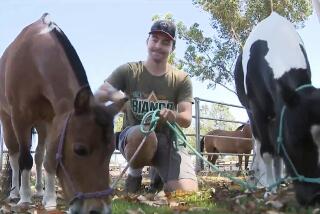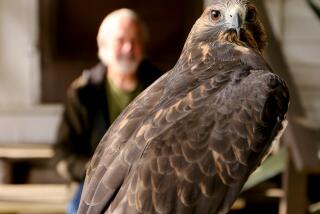Zoning Laws May Force Center That Aids Raptors From Lake Forest Home : In Need of Rescue
- Share via
LAKE FOREST — After treating about 1,000 hurt or starving raptors in a modest backyard aviary, the Birds of Prey Center may have to find another place to roost.
The center, on a quiet residential street, has caught the attention of city officials, who say the organization could be violating local zoning laws.
Fearful of eviction, center workers say they have no idea where they’ll go next. “If they close us down, every hawk and eagle we save will have to be euthanized,” volunteer Jennifer Bush said Tuesday.
Code enforcement officers haven’t inspected the aviary yet, but center founder Scott Weldy said city officials have indicated that he should look for a new shelter site.
“I was told that they would be checking to see what kind of time frame I had to find a better location,” he said.
Created in 1990, the center treats predatory birds, housing up to 40 raptors such as red-tailed hawks, barn owls and the occasional golden eagle in a backyard structure about the size of a three-car garage.
Betty Millan, who allows the center to use the aviary behind her house on El Perro Street, said a next-door neighbor complained about volunteers--but not the birds--making too much noise.
However, El Perro Street residents contacted Tuesday said they’ve never heard a peep coming from the Birds of Prey Center.
“I’ve lived here eight months, I sleep in a bedroom right next to their backyard, and I’ve never heard anything,” said Missy Coplin, who lives on one side of Millan’s home.
But even if there’s been only one complaint, city officials say using a backyard to shelter dozens of wild creatures doesn’t comply with the zoning.
“If it’s brought to our attention that something is going on, and if it’s an activity that isn’t permitted, we have to respond to it,” said Joe Donofrio, city director of human services.
No deadline has been set for the center to move, and Donofrio said the group will be given a reasonable amount of time to find a new home.
“We’re not hitting anyone on the head with a hammer,” he said. “They don’t have to be out next week.”
Raptors with a variety of ailments, from gunshot wounds to starvation, are brought to the center by county Animal Control and Animal Shelter Services officers and members of the public.
Although as many as half die, the rest are released back to the wild once they recover, flying from the hands of a volunteer into the sky.
“It’s a completely emotional kind of high,” said Weldy, a veterinarian who founded and runs the center. “This is not one of those materialistic kind of rewards that you can take home and bank.”
Beside physically caring for injured wildlife, groups such as the Birds of Prey Center “heighten public knowledge of the plight of wildlife,” said Richard Evans, chief of veterinary services for the county.
The Birds of Prey Center is one of only two groups licensed by the state to rehabilitate raptors in Orange County. Weldy said the other is a smaller operation run from a home in North County.
The need to preserve the birds “goes beyond their beauty,” Bush said. “They’re also a real necessary link in the environment. They eat snakes and rodents.”
To city officials, the problem is as much with humans as wildlife. About a dozen volunteers work at the shelter, which presents a potential noise and congestion problem on a quiet residential street.
The shelter is considered a business because it is incorporated as a nonprofit group.
Weldy said the city gave him a list of names of people with land for sale. He has since been busy making phone calls trying to line up a new facility.
“I’m real pig-headed,” he said. “I’m not looking at shutting down. I’m looking over positive options right now.”
More to Read
Sign up for Essential California
The most important California stories and recommendations in your inbox every morning.
You may occasionally receive promotional content from the Los Angeles Times.













